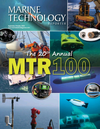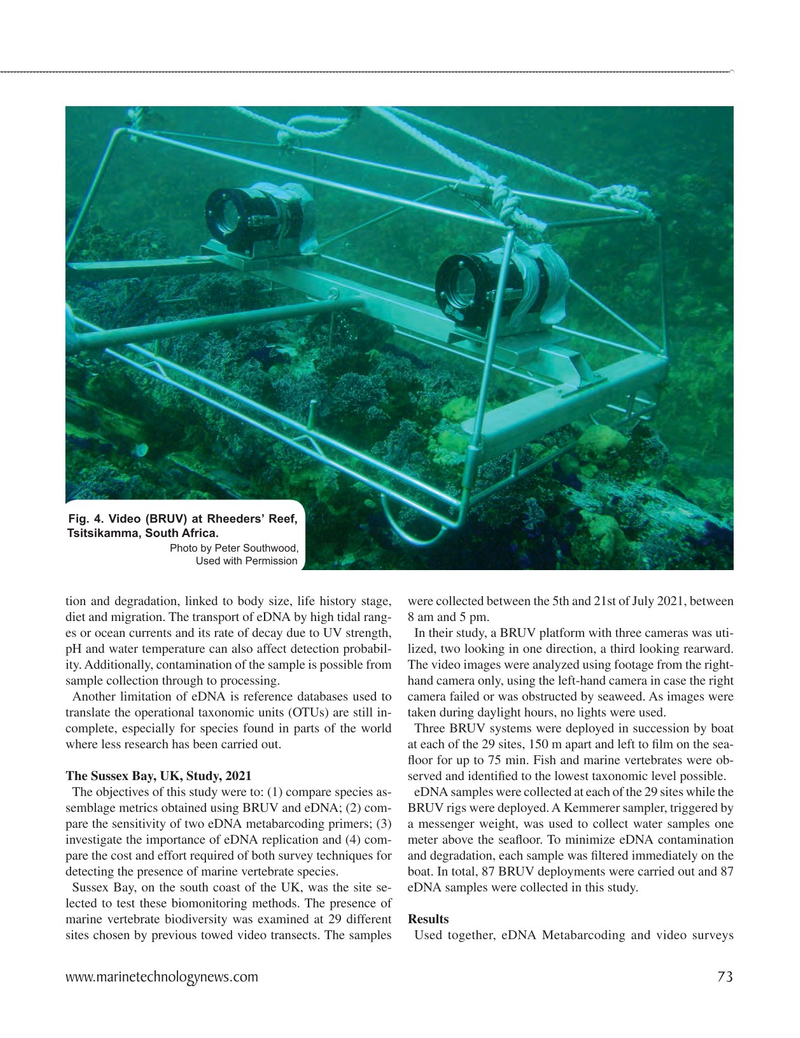
Page 73: of Marine Technology Magazine (September 2025)
Read this page in Pdf, Flash or Html5 edition of September 2025 Marine Technology Magazine
Fig. 4. Video (BRUV) at Rheeders’ Reef,
Tsitsikamma, South Africa.
Photo by Peter Southwood,
Used with Permission tion and degradation, linked to body size, life history stage, were collected between the 5th and 21st of July 2021, between diet and migration. The transport of eDNA by high tidal rang- 8 am and 5 pm. es or ocean currents and its rate of decay due to UV strength, In their study, a BRUV platform with three cameras was uti- pH and water temperature can also affect detection probabil- lized, two looking in one direction, a third looking rearward. ity. Additionally, contamination of the sample is possible from The video images were analyzed using footage from the right- sample collection through to processing. hand camera only, using the left-hand camera in case the right
Another limitation of eDNA is reference databases used to camera failed or was obstructed by seaweed. As images were translate the operational taxonomic units (OTUs) are still in- taken during daylight hours, no lights were used.
complete, especially for species found in parts of the world Three BRUV systems were deployed in succession by boat where less research has been carried out. at each of the 29 sites, 150 m apart and left to ? lm on the sea- ? oor for up to 75 min. Fish and marine vertebrates were ob-
The Sussex Bay, UK, Study, 2021 served and identi? ed to the lowest taxonomic level possible.
The objectives of this study were to: (1) compare species as- eDNA samples were collected at each of the 29 sites while the semblage metrics obtained using BRUV and eDNA; (2) com- BRUV rigs were deployed. A Kemmerer sampler, triggered by pare the sensitivity of two eDNA metabarcoding primers; (3) a messenger weight, was used to collect water samples one investigate the importance of eDNA replication and (4) com- meter above the sea? oor. To minimize eDNA contamination pare the cost and effort required of both survey techniques for and degradation, each sample was ? ltered immediately on the detecting the presence of marine vertebrate species. boat. In total, 87 BRUV deployments were carried out and 87
Sussex Bay, on the south coast of the UK, was the site se- eDNA samples were collected in this study.
lected to test these biomonitoring methods. The presence of marine vertebrate biodiversity was examined at 29 different Results sites chosen by previous towed video transects. The samples Used together, eDNA Metabarcoding and video surveys www.marinetechnologynews.com 73
MTR #7 (66-79).indd 73 MTR #7 (66-79).indd 73 10/8/2025 3:52:25 PM10/8/2025 3:52:25 PM

 72
72

 74
74
